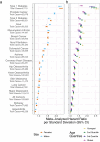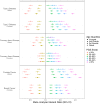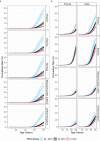A unified framework for estimating country-specific cumulative incidence for 18 diseases stratified by polygenic risk
- PMID: 38866767
- PMCID: PMC11169548
- DOI: 10.1038/s41467-024-48938-2
A unified framework for estimating country-specific cumulative incidence for 18 diseases stratified by polygenic risk
Abstract
Polygenic scores (PGSs) offer the ability to predict genetic risk for complex diseases across the life course; a key benefit over short-term prediction models. To produce risk estimates relevant to clinical and public health decision-making, it is important to account for varying effects due to age and sex. Here, we develop a novel framework to estimate country-, age-, and sex-specific estimates of cumulative incidence stratified by PGS for 18 high-burden diseases. We integrate PGS associations from seven studies in four countries (N = 1,197,129) with disease incidences from the Global Burden of Disease. PGS has a significant sex-specific effect for asthma, hip osteoarthritis, gout, coronary heart disease and type 2 diabetes (T2D), with all but T2D exhibiting a larger effect in men. PGS has a larger effect in younger individuals for 13 diseases, with effects decreasing linearly with age. We show for breast cancer that, relative to individuals in the bottom 20% of polygenic risk, the top 5% attain an absolute risk for screening eligibility 16.3 years earlier. Our framework increases the generalizability of results from biobank studies and the accuracy of absolute risk estimates by appropriately accounting for age- and sex-specific PGS effects. Our results highlight the potential of PGS as a screening tool which may assist in the early prevention of common diseases.
© 2024. The Author(s).
Conflict of interest statement
Kristi Läll has participated as an analyst in a collaboration research project at the Institute of Genomics, University of Tartu, which was funded by Geneto OÜ. Andrea Ganna is the founder of Real World Genetics Oy. Bradley Jermy became an employee of BioMarin after this work was completed. No other authors have competing interests to declare.
Figures




Similar articles
-
Polygenic scores for longitudinal prediction of incident type 2 diabetes in an ancestrally and medically diverse primary care physician network: a patient cohort study.Genome Med. 2024 Apr 26;16(1):63. doi: 10.1186/s13073-024-01337-0. Genome Med. 2024. PMID: 38671457 Free PMC article.
-
Polygenic score analysis identifies distinct genetic risk profiles in Alzheimer's disease comorbidities.Sci Rep. 2025 Apr 3;15(1):11407. doi: 10.1038/s41598-025-95755-8. Sci Rep. 2025. PMID: 40181078 Free PMC article.
-
Polygenic and clinical risk scores and their impact on age at onset and prediction of cardiometabolic diseases and common cancers.Nat Med. 2020 Apr;26(4):549-557. doi: 10.1038/s41591-020-0800-0. Epub 2020 Apr 7. Nat Med. 2020. PMID: 32273609
-
Genetic prediction of complex traits with polygenic scores: a statistical review.Trends Genet. 2021 Nov;37(11):995-1011. doi: 10.1016/j.tig.2021.06.004. Epub 2021 Jul 6. Trends Genet. 2021. PMID: 34243982 Free PMC article. Review.
-
Recent advances in polygenic scores: translation, equitability, methods and FAIR tools.Genome Med. 2024 Feb 19;16(1):33. doi: 10.1186/s13073-024-01304-9. Genome Med. 2024. PMID: 38373998 Free PMC article. Review.
Cited by
-
Polygenic risk scores as a marker for epilepsy risk across lifetime and after unspecified seizure events.Nat Commun. 2024 Jul 25;15(1):6277. doi: 10.1038/s41467-024-50295-z. Nat Commun. 2024. PMID: 39054313 Free PMC article.
-
Screening embryos for polygenic disease risk: a review of epidemiological, clinical, and ethical considerations.Hum Reprod Update. 2024 Oct 1;30(5):529-557. doi: 10.1093/humupd/dmae012. Hum Reprod Update. 2024. PMID: 38805697 Free PMC article. Review.
-
Incorporating genetic data improves target trial emulations and informs the use of polygenic scores in randomized controlled trial design.Nat Genet. 2025 Jul;57(7):1620-1627. doi: 10.1038/s41588-025-02229-8. Epub 2025 Jun 18. Nat Genet. 2025. PMID: 40533517 Free PMC article.
-
Polygenic risk scores as a marker for epilepsy risk across lifetime and after unspecified seizure events.medRxiv [Preprint]. 2023 Nov 27:2023.11.27.23297542. doi: 10.1101/2023.11.27.23297542. medRxiv. 2023. Update in: Nat Commun. 2024 Jul 25;15(1):6277. doi: 10.1038/s41467-024-50295-z. PMID: 38076931 Free PMC article. Updated. Preprint.
-
Perceived risk of type 2 diabetes: Using linked genomic, clinical and questionnaire data to understand the potential use of genetic risk tools in British South Asians.PLOS Glob Public Health. 2025 Mar 31;5(3):e0004274. doi: 10.1371/journal.pgph.0004274. eCollection 2025. PLOS Glob Public Health. 2025. PMID: 40163504 Free PMC article.
References
-
- Goff David C, et al. 2013 ACC/AHA guideline on the assessment of cardiovascular risk. Circulation. 2014;129:S49–S73. - PubMed
-
- Lee, A. et al. BOADICEA: a comprehensive breast cancer risk prediction model incorporating genetic and nongenetic risk factors. Genet. Med.https://www.nature.com/articles/s41436-018-0406-9 (2019). - PMC - PubMed
MeSH terms
Grants and funding
LinkOut - more resources
Full Text Sources

